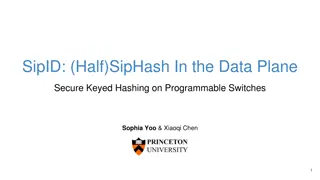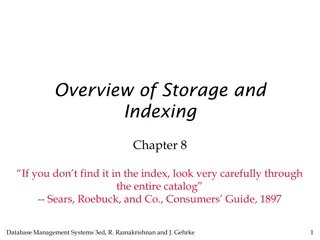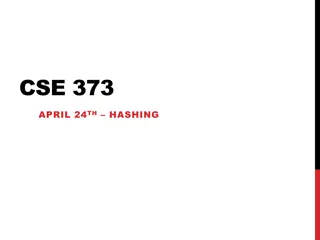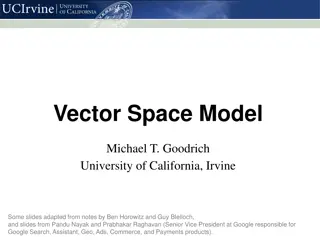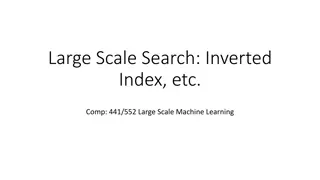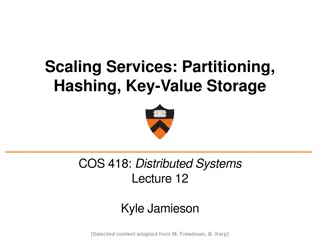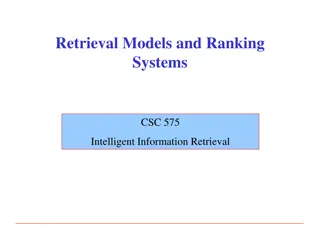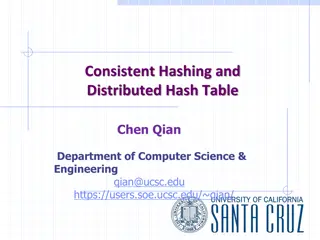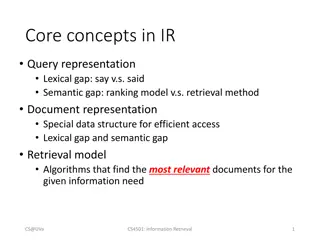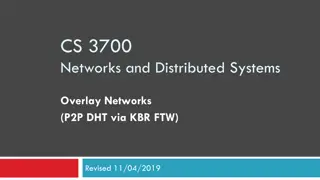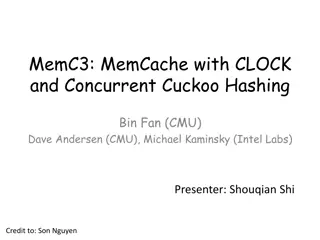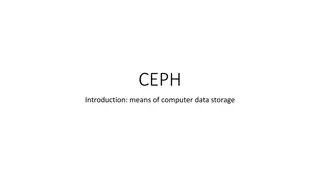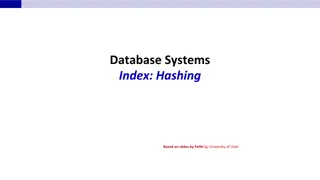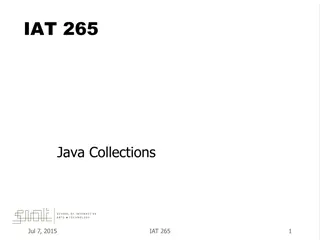Understanding Hashing: Efficient Data Storage and Retrieval
Hashing is a powerful technique for achieving constant time complexity in finding and inserting data. It allows for quick access without the need for ordered elements. Direct addressing, limited hash operations, and efficient storage methods are discussed in this content to optimize data retrieval speed.
Download Presentation

Please find below an Image/Link to download the presentation.
The content on the website is provided AS IS for your information and personal use only. It may not be sold, licensed, or shared on other websites without obtaining consent from the author. Download presentation by click this link. If you encounter any issues during the download, it is possible that the publisher has removed the file from their server.
E N D
Presentation Transcript
HASHING COL 106 Shweta Agrawal, Amit Kumar Slide Courtesy : Linda Shapiro, Uwash Douglas W. Harder, UWaterloo
The Need for Speed Data structures we have looked at so far Use comparison operations to find items Need O(log N) time for Find and Insert In real world applications, N is typically between 100 and 100,000 (or more) log N is between 6.6 and 16.6 Hash tables are an abstract data type designed for O(1) Find and Inserts 12/26/03 Hashing - Lecture 10 2
Fewer Functions Faster compare lists and stacks by reducing the flexibility of what we are allowed to do, we can increase the performance of the remaining operations insert(L,X) into a list versus push(S,X) onto a stack compare trees and hash tables trees provide for known ordering of all elements hash tables just let you (quickly) find an element 12/26/03 Hashing - Lecture 10 3
Limited Set of Hash Operations For many applications, a limited set of operations is all that is needed Insert, Find, and Delete Note that no ordering of elements is implied For example, a compiler needs to maintain information about the symbols in a program user defined language keywords Say that our data has format (key, value). How should we store it for efficient insert, find, delete?
Direct Address Tables Direct addressing using an array is very fast Assume keys are integers in the set U={0,1, m-1} m is small no two elements have the same key Then just store each element at the array location array[key] search, insert, and delete are trivial 12/26/03 Hashing - Lecture 10 5
Direct Access Table table key data 0 U (universe of keys) 0 1 2 9 2 7 4 6 3 1 3 2 4 K 3 5 5 (Actual keys) 6 5 8 7 8 8 9 12/26/03 Hashing - Lecture 10 6
An Issue If most keys in U are used direct addressing can work very well (m small) The largest possible key in U , say m, may be much larger than the number of elements actually stored (|U| much greater than |K|) the table is very sparse and wastes space in worst case, table too large to have in memory If most keys in U are not used need to map U to a smaller set closer in size to K 12/26/03 Hashing - Lecture 10 7
Mapping the Keys Key Universe U 0 K 72345 432 table 254 3456 key data 52 0 54724 928104 81 1 254 103673 2 3 0 3456 7 4 4 Hash Function 6 5 9 54724 6 2 3 1 7 5 Table indices 8 8 81 9 12/26/03 Hashing - Lecture 10 8
Hashing Schemes We want to store N items in a table of size M, at a location computed from the key K (which may not be numeric!) Hash function Method for computing table index from key Need of a collision resolution strategy How to handle two keys that hash to the same index 12/26/03 Hashing - Lecture 10 9
Find an Element in an Array Key element Data records can be stored in arrays. A[0] = { CHEM 110 , Size 89} A[3] = { CSE 142 , Size 251} A[17] = { CSE 373 , Size 85} Class size for CSE 373? Linear search the array O(N) worst case time Binary search - O(log N) worst case 12/26/03 Hashing - Lecture 10 10
Go Directly to the Element What if we could directly index into the array using the key? A[ CSE 373 ] = {Size 85} Main idea behind hash tables Use a key based on some aspect of the data to index directly into an array O(1) time to access records 12/26/03 Hashing - Lecture 10 11
Indexing into Hash Table Need a fast hash function to convert the element key (string or number) to an integer (the hash value) (i.e, map from U to index) Then use this value to index into an array Hash( CSE 373 ) = 157, Hash( CSE 143 ) = 101 Output of the hash function must always be less than size of array should be as evenly distributed as possible 12/26/03 Hashing - Lecture 10 12
Choosing the Hash Function What properties do we want from a hash function? Want universe of hash values to be distributed randomly to minimize collisions Don t want systematic nonrandom pattern in selection of keys to lead to systematic collisions Want hash value to depend on all values in entire key and their positions 12/26/03 Hashing - Lecture 10 13
The Key Values are Important Notice that one issue with all the hash functions is that the actual content of the key set matters The elements in K (the keys that are used) are quite possibly a restricted subset of U, not just a random collection variable names, words in the English language, reserved keywords, telephone numbers, etc, etc 12/26/03 Hashing - Lecture 10 14
Simple Hashes It's possible to have very simple hash functions if you are certain of your keys For example, suppose we know that the keys s will be real numbers uniformly distributed over 0 s < 1 Then a very fast, very good hash function is hash(s) = floor(s m) where m is the size of the table 12/26/03 Hashing - Lecture 10 15
Example of a Very Simple Mapping hash(s) = floor(s m) maps from 0 s < 1 to 0..m-1 Example m = 10 s 0.0 0.1 0.2 0.3 0.4 0.5 0.6 0.7 0.8 0.9 floor(s*m) 0 1 2 3 4 5 6 7 8 9 Note the even distribution. There are collisions, but we will deal with them later. 16
Perfect Hashing In some cases it's possible to map a known set of keys uniquely to a set of index values You must know every single key beforehand and be able to derive a function that works one-to-one s 120 331 912 74 665 47 888 219 hash(s) 0 1 2 3 4 5 6 7 8 9 12/26/03 Hashing - Lecture 10 17
Mod Hash Function One solution for a less constrained key set modular arithmetic a mod size remainder when "a" is divided by "size" in C or Java this is written as r = a % size; If TableSize = 251 408 mod 251 = 157 352 mod 251 = 101 12/26/03 Hashing - Lecture 10 18
Modulo Mapping a mod m maps from integers to 0..m-1 one to one? no onto? yes x -4 -3 -2 -1 0 1 2 3 4 5 6 7 x mod 4 0 1 2 3 0 1 2 3 0 1 2 3 12/26/03 Hashing - Lecture 10 19
Hashing Integers If keys are integers, we can use the hash function: Hash(key) = key mod TableSize Problem 1: What if TableSize is 11 and all keys are 2 repeated digits? (eg, 22, 33, ) all keys map to the same index Need to pick TableSize carefully: often, a prime number 12/26/03 Hashing - Lecture 10 20
Nonnumerical Keys Many hash functions assume that the universe of keys is the natural numbers N={0,1, } Need to find a function to convert the actual key to a natural number quickly and effectively before or during the hash calculation Generally work with the ASCII character codes when converting strings to numbers 12/26/03 Hashing - Lecture 10 21
Characters to Integers If keys are strings can get an integer by adding up ASCII values of characters in key We are converting a very large string c0c1c2 cn to a relatively small number c0+c1+c2+ +cn mod size. C S E 3 7 3 <0> character 67 83 69 32 51 55 51 0 ASCII value 12/26/03 Hashing - Lecture 10 22
Hash Must be Onto Table Problem 2: What if TableSize is 10,000 and all keys are 8 or less characters long? chars have values between 0 and 127 Keys will hash only to positions 0 through 8*127 = 1016 Need to distribute keys over the entire table or the extra space is wasted 12/26/03 Hashing - Lecture 10 23
Problems with Adding Characters Problems with adding up character values for string keys If string keys are short, will not hash evenly to all of the hash table Different character combinations hash to same value abc , bca , and cab all add up to the same value (recall this was Problem 1) 12/26/03 Hashing - Lecture 10 24
Characters as Integers A character string can be thought of as a base 256 number. The string c1c2 cn can be thought of as the number cn + 256cn-1 + 2562cn-2+ + 256n-1 c1 Use Horner s Rule to Hash! r= 0; for i = 1 to n do r := (c[i] + 256*r) mod TableSize 25
Collisions A collision occurs when two different keys hash to the same value E.g. For TableSize = 17, the keys 18 and 35 hash to the same value for the mod17 hash function 18 mod 17 = 1 and 35 mod 17 = 1 Cannot store both data records in the same slot in array! 12/26/03 Hashing - Lecture 10 26
Collision Resolution Separate Chaining Use data structure (such as a linked list) to store multiple items that hash to the same slot Open addressing (or probing) search for empty slots using a second function and store item in first empty slot that is found 12/26/03 Hashing - Lecture 10 27
Resolution by Chaining Each hash table cell holds pointer to linked list of records with same hash value Collision: Insert item into linked list To Find an item: compute hash value, then do Find on linked list Note that there are potentially as many as TableSize lists 0 1 2 3 4 5 6 7 bug zurg hoppi 12/26/03 Hashing - Lecture 10 28
Why Lists? Can use List ADT for Find/Insert/Delete in linked list O(N) runtime where N is the number of elements in the particular chain Can also use Binary Search Trees O(log N) time instead of O(N) But the number of elements to search through should be small (otherwise the hashing function is bad or the table is too small) generally not worth the overhead of BSTs 12/26/03 Hashing - Lecture 10 29
Load Factor of a Hash Table Let N = number of items to be stored Load factor L = N/TableSize TableSize = 101 and N =505, then L = 5 TableSize = 101 and N = 10, then L = 0.1 Average length of chained list = L and so average time for accessing an item = O(1) + O(L) Want L to be smaller than 1 but close to 1 if good hashing function (i.e. TableSize N) With chaining hashing continues to work for L > 1 12/26/03 Hashing - Lecture 10 30
Resolution by Open Addressing All keys are in the table - no links Reduced overhead saves space Cell Full? Keep Looking A probe sequence: h1(k),h2(k), h3(k), Searching/inserting k: check locations h1(k), h2(k), h3(k) Deletion k: Lazy deletion needed mark a cell that was deleted Various flavors of open addressing differ in which probe sequence they use
Cell Full? Keep Looking. hi(X)=(Hash(X)+F(i)) mod TableSize Define F(0) = 0 F is the collision resolution function. Some possibilities: Linear: F(i) = i Quadratic: F(i) = i2 Double Hashing: F(i) = i Hash2(X) 12/26/03 Hashing - Lecture 10 32
Linear Probing When searching for K, check locations h(K), h(K)+1, h(K)+2, mod TableSize until either K is found; or we find an empty location (K not present) If table is very sparse, almost like separate chaining. When table starts filling, we get clustering but still constant average search time. Full table => infinite loop. 12/26/03 Hashing - Lecture 10 33
Linear Probing Example Insert(93) (2) Insert(47) (5) Insert(10) (3) Insert(55) (6) Insert(76) (6) Insert(40) (5) 0 1 2 3 4 5 6 0 1 2 3 4 5 6 0 1 2 3 4 5 6 47 0 1 2 3 4 5 6 47 0 1 2 3 4 5 6 47 55 93 10 0 1 2 3 4 5 6 93 93 93 93 10 40 76 40 76 40 76 40 76 76 76 Probes 1 1 1 3 1 3 H(x)= x mod 7
Deletion: Open Addressing Must do lazy deletion: Deleted keys are marked as deleted Find: done normally Insert: treat marked slot as an empty slot and fill it 0 1 2 3 4 5 6 0 1 2 3 4 5 6 0 1 2 3 4 5 6 h(k) = k mod 7 Linear probing 16 16 23 59 16 30 59 mark 59 Try: Delete 23 Find 59 Insert 30 76 76 76
Linear Probing Example: search(47) (5) delete(40) (5) 0 1 2 3 4 5 6 47 55 93 10 0 1 2 3 4 5 6 47 55 93 10 0 1 2 3 4 5 6 47 93 H(k)= k mod 7 40 76 x x 76 76 Probes 1 3
Another example Insert these numbers into this initially empty hash table: 19A, 207, 3AD, 488, 5BA, 680, 74C, 826, 946, ACD, B32, C8B, DBE, E9C 0 1 2 3 4 5 6 7 8 9 A B C D E F
Example Start with the first four values: 19A, 207, 3AD, 488 0 1 2 3 4 5 6 7 8 9 A B C D E F
Example Start with the first four values: 19A, 207, 3AD, 488 0 1 2 3 4 5 6 7 207 488 8 9 A 19A B C D 3AD E F
Example Next we must insert 5BA 0 1 2 3 4 5 6 7 207 488 8 9 A 19A B C D 3AD E F
Example Next we must insert 5BA Bin A is occupied We search forward for the next empty bin 2 3 4 5 6 7 207 488 0 1 8 9 A 19A 5BA B C D 3AD E F
Example Next we are adding 680, 74C, 826 0 1 2 3 4 5 6 7 207 488 8 9 A 19A 5BA B C D 3AD E F
Example Next we are adding 680, 74C, 826 All the bins are empty simply insert them 0 680 1 2 3 4 5 6 826 207 488 7 8 9 A 19A 5BA 74C 3AD B C D E F
Example Next, we must insert 946 0 680 1 2 3 4 5 6 826 207 488 7 8 9 A 19A 5BA 74C 3AD B C D E F
Example Next, we must insert 946 Bin 6 is occupied The next empty bin is 9 2 3 4 5 0 680 1 6 826 207 488 946 19A 5BA 74C 3AD 7 8 9 A B C D E F
Example Next, we must insert ACD 0 680 1 2 3 4 5 6 826 207 488 946 19A 5BA 74C 3AD 7 8 9 A B C D E F
Example Next, we must insert ACD Bin D is occupied The next empty bin is E 2 3 4 5 0 680 1 6 826 207 488 946 19A 5BA 74C 3ADACD 7 8 9 A B C D E F
Example Next, we insert B32 0 680 1 2 3 4 5 6 826 207 488 946 19A 5BA 74C 3ADACD 7 8 9 A B C D E F
Example Next, we insert B32 Bin 2 is unoccupied 0 680 1 2 B32 3 4 5 6 826 207 488 946 19A 5BA 74C 3ADACD 7 8 9 A B C D E F
Example Next, we insert C8B 0 680 1 2 B32 3 4 5 6 826 207 488 946 19A 5BA 74C 3ADACD 7 8 9 A B C D E F




